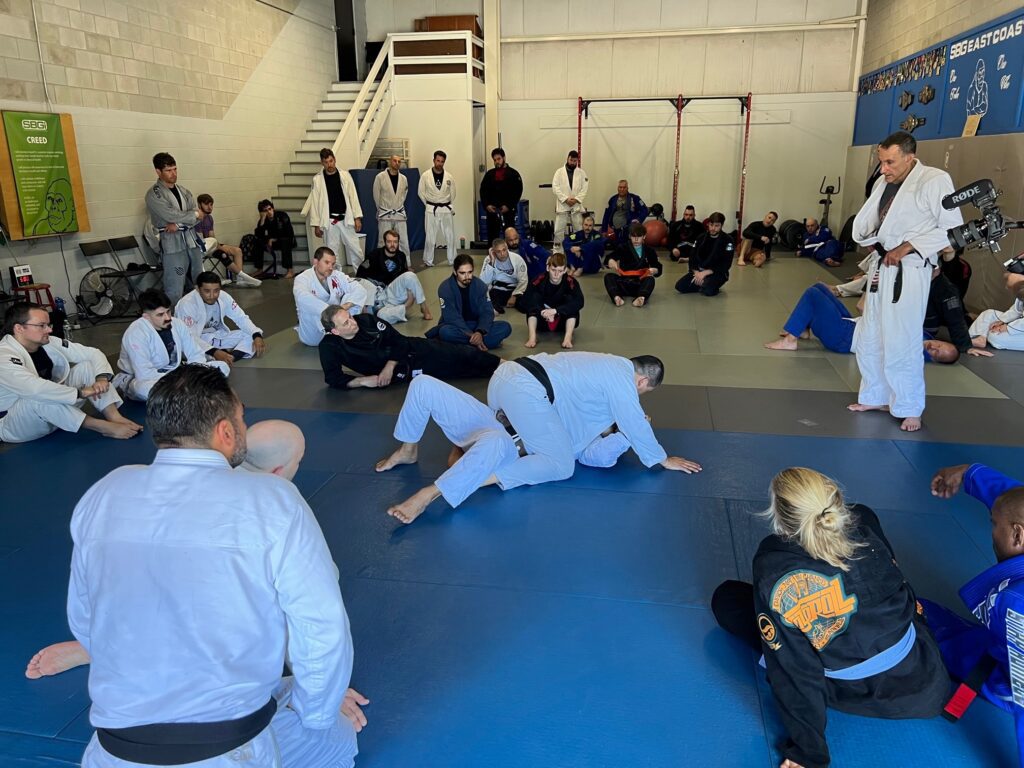
This pic was from one of the seminars we hosted with my good friend, Henry Akins.
I value these experiences tremendously, both in terms of Jiu-Jitsu and friendship. There is always something new and enriching to take away in all respects.
The night before the seminar started, we were talking about how much simpler Jiu-Jitsu can be than how most people learn and apply it (even those who are very proficient).
He mentioned that in his first few years with Rickson, there was no talk about “connection” or “invisible Jiu-Jitsu.” But gradually and increasingly, that started to change and then for over a decade the refinement of the techniques and approach was profound….
As Rickson later described, he was able to get away with certain things in his earlier career because he was in great shape and athletically inclined. But it was only later that he developed what he called the “full connection” (maximum efficiency) in all the fundamental positions and movements.
The trouble is, when people haven’t had the opportunity to spend a good amount of time feeling that invisible Jiu-Jitsu, which is all about creating those full connections –– all about the first principles of human movement as it pertains to grappling –– then their default tendency is to associate it with concepts they are more familiar with and techniques they have experienced.
“Most people use the term ‘connection’ but when you see what they’re doing or feel it you can tell that they don’t actually understand it,” he said simply.
I shared the following distinction with him as a way to describe this phenomenon and he really seemed to like it. I’ll share it with you as well:
The difference between complex and complicated systems
These are very different things even though they’re often used synonymously.
Complex systems, like the human body, the weather, ecosystems, etc., are adaptive, dynamic, multivariant and nonlinear.
Complicated systems, on the other hand, like clockworks or social media algorithms, are more formulaic and linear.
Really think about that.
Clearly Jiu-Jitsu, because it is so aligned to reality and the dynamic nature of grappling resisting opponents of all different shapes, sizes, and styles of play, is a complex system.
Early on, in the aftermath of the first UFCs where Royce Gracie brought the effectiveness of BJJ into public awareness, the art was set apart from classic martial arts not only in its strategic emphasis on ground fighting, but also in terms of its training methods –– i.e., no theoretical moves performed without resistance, no kata (prearranged sequences), no prescribed sparring drills (like one-step “sparring” with pre-determined feeds from a partner).
In other words, Jiu-Jitsu was so effective because it eliminated so much of the abstraction and theory from the approach to learning. Rather than speculate that you can shatter someone’s knee with a side kick, in Jiu-Jitsu you know if you can submit someone because they were actually trying not to tap but you made them tap, and vice versa.
And for that reason, Jiu-Jitsu (as a complex system) stayed much more closely aligned to reality than most traditional martial arts (complicated systems), which tended to focus more on accumulation of theoretical knowledge than development of functional skills…
For example, having one’s status and rank associated with knowing and/or being tested on being able to learn and perform more advanced techniques, katas, sequences, etc.
I think most grapplers acknowledge this functional difference.
But here’s where the confusion sets in…
When it comes to how they think about and learn Jiu-Jitsu, very few truly understand which system they’re actually operating in.
(I say this without judgment, because as conceptually minded as I tend to be, I was absolutely blind to this for a long time.)
Meaning, they can be excellent practitioners or excellent teachers in terms of their ability to explain and break down techniques.
What I’m talking about has nothing to do with a lack of skill or knowledge.
Instead, it’s about aligning one’s approach to learning, problem solving, and coaching to the complex, adaptive, nonlinear nature of Jiu-Jitsu, which is a complex, adaptive, and nonlinear system.
Because although BJJ is light years ahead of traditional martial arts in terms of its training paradigm, within BJJ there is still a fundamental tendency to think about and learn the art as though it was a complicated system.
Specific examples of this include teaching/practicing/thinking about:
- Moves (specific techniques) vs movement (prescriptions vs universal first principles)
- Step-by-step, “if/then” technical sequences vs connection
- Creating new technical systems to beat existing technical systems
- Etc.
In fact, after all these years it’s been my observation that a lot of very smart and capable grapplers have difficulty thinking about Jiu-Jitsu in any way other than the above.
And it’s certainly the case that training with the above approaches can work, even at the very highest competitive levels.
But it still means adding layers of unnecessary complexity (complicated system) rather than navigating an irreducible amount of complexity (complex system).
As a metaphor for this, think about different models for approaching global financial markets. Historically those who follow a probabilistic investment approach (like the great Ray Dalio, the Rickson of the hedge fund world) perform the best because they embrace and account for the inevitable volatility and complexity of reality, such as outlier “black swan” events, whereas those who follow more predictive investment approaches tend to be caught out when these occur, regardless of how sophisticated their algorithms might be.
For example, how well did the predictive approaches fare in early 2020 when we were blindsided by a global pandemic?
And make no mistake, just like weather or financial markets, Jiu-Jitsu is irreducibly complex. But it doesn’t have to be complicated.
Here’s the paradox I really want you to understand, and then most importantly, implement into your thinking and training:
When you approach Jiu-Jitsu always according to first principles, you can navigate its irreducible complexity in such a way that you can dramatically simplify it for yourself (and/or your students if you’re an instructor).
That always means doing less, not more, both in terms of physical energy and the amount of movements or steps involved in achieving an outcome.
When you approach Jiu-Jitsu as though it were a complicated system, however, you can still achieve those desired outcomes, but it will necessarily involve doing more –– addition, not subtraction –– requiring more physical energy and/or more movements or steps to get an outcome. It’s never a case of good/bad. It’s all about aligning and optimizing.
For more first principles based instruction on all areas of the game to help you accelerate your learning curve, visit the complete 40 Plus BJJ and First Principles Jiu-Jitsu library here.
